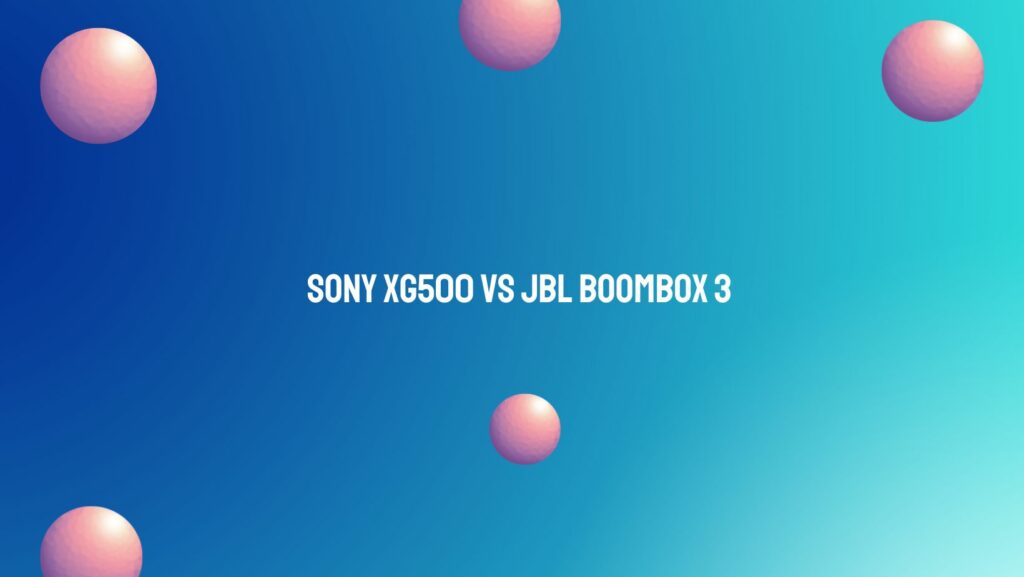In the ever-evolving landscape of portable audio, the Sony XG500 and JBL Boombox 3 emerge as titans, promising an unparalleled auditory experience for enthusiasts seeking the epitome of portable sound. As technology continues to push the boundaries of what’s possible in compact audio solutions, a comprehensive comparison of these two powerhouses becomes imperative. Join us on a journey through the features, strengths, and distinctive attributes of the Sony XG500 and JBL Boombox 3 to navigate the realm of portable audio and make an informed decision.
Design and Construction:
The Sony XG500 arrives on the scene with a sleek and modern design, seamlessly blending form and function. Its fabric finish and compact form factor exude sophistication, making it an aesthetic addition to any setting. The JBL Boombox 3, in contrast, embraces a robust and utilitarian design. With a durable, rubberized exterior and a handle for easy portability, it stands as a rugged companion suited for both indoor and outdoor adventures.
Both speakers are built to withstand the rigors of daily life, offering water and dust resistance. The Sony XG500 flaunts an IP66 rating, making it resistant to water jets and dust ingress. On the other hand, the JBL Boombox 3 boasts an even higher IP67 rating, ensuring not only dust-tight construction but also the ability to be submerged in water up to one meter for 30 minutes.
Audio Prowess:
When it comes to audio performance, both the Sony XG500 and JBL Boombox 3 go beyond the ordinary. The XG500, armed with a powerful combination of two tweeters, two midrange drivers, and a dedicated subwoofer, delivers a rich and immersive sound experience. Sony’s advanced sound processing technologies, including Live Sound and Extra Bass, further enhance the audio, creating a three-dimensional listening experience that envelops the user.
The JBL Boombox 3, true to its name, is equipped with four active transducers and two JBL Bass Radiators, producing an earth-shaking bass and crisp highs. JBL’s PartyBoost feature allows for the wireless connection of multiple JBL PartyBoost-enabled speakers, creating a synchronized and expansive audio environment. The Boombox 3 excels in delivering a powerful audio output, making it ideal for those who crave bass-heavy genres and dynamic soundscapes.
Connectivity and Endurance:
In terms of connectivity, both speakers offer Bluetooth compatibility for wireless streaming, ensuring a seamless connection to various devices. The Sony XG500 stands out with its LDAC technology, allowing for high-resolution audio streaming with minimal loss in quality. The JBL Boombox 3, meanwhile, supports Bluetooth 5.1 for enhanced stability and range.
When it comes to battery life, the Sony XG500 provides an impressive 30 hours of playback on a single charge, ensuring extended periods of uninterrupted music enjoyment. The JBL Boombox 3, while slightly less with a claimed 24 hours of playtime, compensates with a mammoth 10,000mAh battery that also serves as a power bank, allowing users to charge their devices on the go.
Conclusion:
In the clash of the audio titans – Sony XG500 vs. JBL Boombox 3 – each speaker brings forth a unique set of features and strengths. The Sony XG500 appeals to those who value a sleek design, advanced audio processing technologies, and an extended battery life. In contrast, the JBL Boombox 3 caters to the power-hungry listener, offering a rugged build, thunderous bass, and the versatility of PartyBoost connectivity.
Ultimately, the choice between the Sony XG500 and JBL Boombox 3 rests on individual preferences, lifestyle, and the sonic characteristics that resonate with your musical taste. Whether you prioritize style, durability, or audio performance, both these audio giants deliver a compelling package that raises the bar for portable sound.


